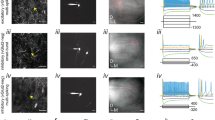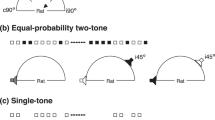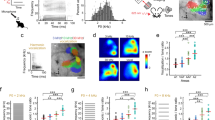Abstract
Microsecond differences in the arrival time of a sound at the two ears (interaural time differences, ITDs) are the main cue for localizing low-frequency sounds in space. Traditionally, ITDs are thought to be encoded by an array of coincidence-detector neurons, receiving excitatory inputs from the two ears via axons of variable length (‘delay lines’), to create a topographic map of azimuthal auditory space1,2. Compelling evidence for the existence of such a map in the mammalian lTD detector, the medial superior olive (MSO), however, is lacking. Equally puzzling is the role of a—temporally very precise3—glycine-mediated inhibitory input to MSO neurons. Using in vivo recordings from the MSO of the Mongolian gerbil, we found the responses of ITD-sensitive neurons to be inconsistent with the idea of a topographic map of auditory space. Moreover, local application of glycine and its antagonist strychnine by iontophoresis (through glass pipette electrodes, by means of an electric current) revealed that precisely timed glycine-controlled inhibition is a critical part of the mechanism by which the physiologically relevant range of ITDs is encoded in the MSO. A computer model, simulating the response of a coincidence-detector neuron with bilateral excitatory inputs and a temporally precise contralateral inhibitory input, supports this conclusion.
This is a preview of subscription content, access via your institution
Access options
Subscribe to this journal
Receive 51 print issues and online access
$199.00 per year
only $3.90 per issue
Buy this article
- Purchase on Springer Link
- Instant access to full article PDF
Prices may be subject to local taxes which are calculated during checkout




Similar content being viewed by others
References
Jeffress, L. A. A place theory of sound localization. J. Comp. Physiol. Psychol. 41, 35–39 (1948)
Joris, P. X., Smith, P. H. & Yin, T. C. Coincidence detection in the auditory system: 50 years after Jeffress. Neuron 21, 1235–1238 (1988)
Grothe, B. & Sanes, D. H. Synaptic inhibition influences the temporal coding properties of medial superior olivary neurons: an in vitro study. J. Neurosci. 14, 1701–1709 (1994)
Klumpp, R. & Eady, H. Some measurements of interaural time difference thresholds. J. Acoust. Soc. Am. 28, 215–232 (1956)
Overholt, E., Rubel, E. W. & Hyson, R. L. A circuit for coding interaural time differences in the chick brainstem. J. Neurosci. 12, 1698–1708 (1992)
Carr, C. E. & Konishi, M. Axonal delay lines for time measurement in the owl's brainstem. Proc. Natl Acad. Sci. USA 85, 8311–8315 (1988)
Smith, P. H., Joris, P. X. & Yin, T. C. Projections of physiologically characterized spherical bushy cell axons from the cochlear nucleus of the cat: evidence for delay lines to the medial superior olive. J. Comp. Neurol. 331, 245–260 (1993)
Grothe, B. The evolution of temporal processing in the medial superior olive, an auditory brainstem structure. Prog. Neurobiol. 61, 581–610 (2000)
Yin, T. C. & Chan, J. C. Interaural time sensitivity in medial superior olive of cat. J. Neurophys. 64, 465–488 (1990)
Spitzer, M. W. & Semple, M. N. Neurons sensitive to interaural phase disparity in gerbil superior olive: diverse monaural and temporal response properties. J. Neurophys. 73, 1668–1690 (1995)
Cant, N. B. & Hyson, R. L. Projections from the lateral nucleus of the trapezoid body to the medial superior olivary nucleus in the gerbil. Hearing Res. 58, 26–34 (1992)
Kuwabara, N. & Zook, J. M. Projections to the medial superior olive from the medial and lateral nuclei of the trapezoid body in rodents and bats. J. Comp. Neurol. 324, 522–538 (1992)
Grothe, B. & Sanes, D. H. Bilateral inhibition by glycinergic afferents in the medial superior olive. J. Neurophys. 69, 1192–1196 (1993)
Smith, A. J., Owens, S. & Forsythe, I. D. Characterisation of inhibitory and excitatory postsynaptic currents of the rat medial superior olive. J. Physiol. 529, 681–698 (2000)
Grothe, B. & Park, T. J. Sensitivity to interaural time differences in the medial superior olive of a small mammal, the Mexican free-tailed bat. J. Neurosci. 18, 6608–6622 (1998)
Heffner, R. S. & Heffner, H. E. Sound localization and use of binaural cues by the gerbil (Meriones unguiculatus). Behav. Neurosci. 102, 422–428 (1988)
McAlpine, D., Jiang, D. & Palmer, A. R. A neural code for low-frequency sound localization in mammals. Nature Neurosci. 4, 396–401 (2001)
Grothe, B., Park, T. J. & Schuller, G. Medial superior olive in the free-tailed bat: response to pure tones and amplitude-modulated tones. J. Neurophys. 77, 1553–1565 (1997)
Rothman, J. S., Young, E. D. & Manis, P. B. Convergence of auditory nerve fibers onto bushy cells in the ventral cochlear nucleus: implications of a computational model. J. Neurophys. 70, 2562–2583 (1993)
Smith, P. H., Joris, P. X. & Yin, T. C. Anatomy and physiology of principal cells of the medial nucleus of the trapezoid body (MNTB) of the cat. J. Neurophys. 79, 3127–3142 (1998)
Taschenberger, H. & von Gersdorff, H. Fine-tuning an auditory synapse for speed and fidelity: developmental changes in presynaptic waveform, EPSC kinetics, and synaptic plasticity. J. Neurosci. 20, 9162–9173 (2000)
Grothe, B. Interaction of excitation and inhibition in processing of pure tone and amplitude-modulated stimuli in the medial superior olive of the mustached bat. J. Neurophys. 71, 706–721 (1994)
Kapfer, C., Seidl, A. H., Schweizer, H. & Grothe, B. Experience-dependent refinement of inhibitory inputs to auditory coincidence-detector neurons. Nature Neurosci. 5, 257–253 (2002)
Willott, J. F., Milbrandt, J. C., Bross, L. S. & Caspary, D. M. Glycine immunoreactivity and receptor binding in the cochlear nucleus of c57bl/6j and cba/caj mice: effects of cochlear impairment and aging. J. Comp. Neurol. 385, 405–414 (1997)
Goldberg, J. M. & Brown, P. B. Response of binaural neurons of dog superior olivary complex to dichotic tonal stimuli: some physiological mechanisms of sound localization. J. Neurophys. 32, 613–636 (1969)
Havey, D. C. & Caspary, D. M. A simple technique for constructing ‘piggy-back’ multibarrel microelectrodes. Electroencephalogr. Clin. Neurophys. 48, 249–251 (1980)
Brand, A., Urban, A. & Grothe, B. Duration tuning in the mouse auditory midbrain. J. Neurophys. 84, 1790–1799 (2000)
Yin, T. C. & Kuwada, S. Binaural interaction in low-frequency neurons in inferior colliculus of the cat. III. Effects of changing frequency. J. Neurophys. 50, 1020–1042 (1983)
Brughera, A. R., Stutman, E. R., Carney, L. H. & Colburn, H. S. A model with exitation and inhibition for cells in the medial superior olive. Audit. Neurosci. 2, 219–233 (1996)
Carney, L. H. A model for the responses of low-frequency auditory-nerve fibers in cat. J. Acoust. Soc. Am. 93, 401–417 (1993)
Acknowledgements
We thank G. Breutel for technical assistance, C. Kapfer for suggestions, and M. Goetz for critical comments on the manuscript. This work was supported by the German Research Foundation (A.B., O.B., B.G.) and by the Medical Research Council (T.M., D.M.).
Author information
Authors and Affiliations
Corresponding author
Ethics declarations
Competing interests
The authors declare that they have no competing financial interests.
Rights and permissions
About this article
Cite this article
Brand, A., Behrend, O., Marquardt, T. et al. Precise inhibition is essential for microsecond interaural time difference coding. Nature 417, 543–547 (2002). https://doi.org/10.1038/417543a
Received:
Accepted:
Issue Date:
DOI: https://doi.org/10.1038/417543a
This article is cited by
-
Structure and dynamics that specialize neurons for high-frequency coincidence detection in the barn owl nucleus laminaris
Biological Cybernetics (2023)
-
Are frog calls relatively difficult to locate by mammalian predators?
Journal of Comparative Physiology A (2023)
-
Simulation of ITD-Dependent Single-Neuron Responses Under Electrical Stimulation and with Amplitude-Modulated Acoustic Stimuli
Journal of the Association for Research in Otolaryngology (2022)
-
Ambient noise exposure induces long-term adaptations in adult brainstem neurons
Scientific Reports (2021)
Comments
By submitting a comment you agree to abide by our Terms and Community Guidelines. If you find something abusive or that does not comply with our terms or guidelines please flag it as inappropriate.



